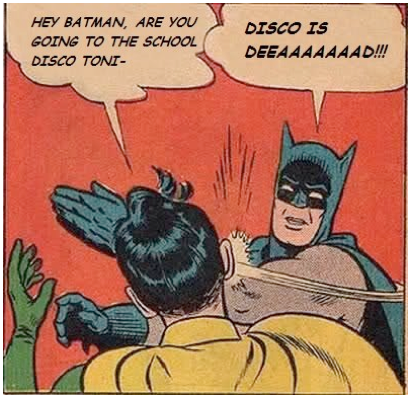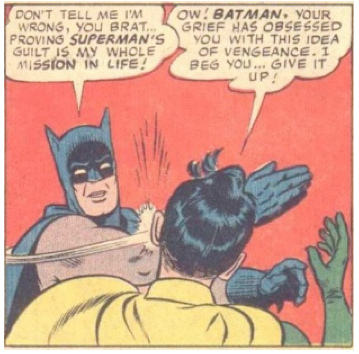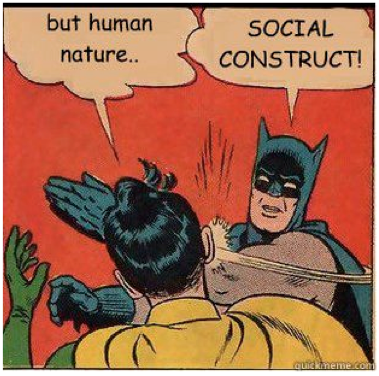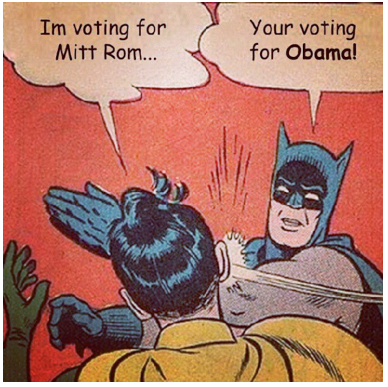Making Sense of Memes: Where They Came From and Why We Keep Clicking Them
By
2014, Vol. 6 No. 03 | pg. 2/2 | « On the topic of how memes came to be, and when they are used, it is important to emphasize that not all memes are used to communicate the same things. In the case of Batman Slapping Robin, the image used is an illustration, but some memes use photographs. The example of memes that use illustrations and drawings provide an example of how the type of image used impact the meme, and on its understanding by audiences. In Regarding the Pain of Others, Susan Sontag (2003) addressed the importance of photography in conveying, for the viewers and photographers, human suffering. She shortly compared drawings and photographs, and explained why the latter is preferred when it comes to communicating suffering: “[some images can act like] a synthesis. They claim: things like this happened. In contrast, a single photograph or filmstrip claims to represent exactly what was before the camera’s lens” (Sontag, 2003, p.47). Memes do not need to be photographs as their purpose could be to communicate that things similar to the illustration happened; in the case of the Batman Slapping Robin, the image is needed for its generality. Some memes are photographs, but not all memes are photographs: illustrations allow creators of memes to play with the generality of the illustration. This permits the final result, or what it is that the meme shares, to gain in irony, which is often the purpose of Internet memes (See Figure 4). Generality, ambiguity and the superposition of different meanings give substance to a meme. They can be found in the conflict between what is being said and what is being portrayed by the image, and they can also exist in the dissonance between the original context of the image and how the image ended up being used as a meme. Fig 4. Another variation of the “My Parents are Dead” first meme.
Where do Memes Originate?The images memes use are photographs or illustrations taken out of their initial context and replicated. In the Batman Slapping Robin case, the original panel can be found in a comic book published in 1965 (Know Your Meme, 2013; see Figure 5). The first known meme created out of the comic book was published on June 10th, 2008, on SFWChan, a website dedicated to user-generated content, mostly memes. The text in the initial speech bubble was changed to make the meme, newly created from the ensemble of image and text, funny. From this point until now, it was impossible to trace back the changes and spread of the meme. New meanings of the image used in the meme, created by its actualization and adaptation, do not contradict in any way the initial context of the image. Fig 5. The original panel of the comic book.
Considering memes as palimpsest will then help us understand the working of memes. In The Work of Art in the Age of Mechanical Reproduction, Walter Benjamin (1988) addressed the possibilities of reproduction when compared to original work of art. He wrote: “technical reproduction can put the copy of the original into situations which would be out of reach for the original itself.” (Benjamin, 1998, p.4). Memes are photographs or illustrations taken out of their initial context and continually adapted or actualized to new ones. In other words, memes are endless “reproductions” put “into situations which would be out of reach for the original itself” (Benjamin, 1998, p.4). This process, the process of adapting memes to situations that would be out of reach for the original image, is exactly what makes a meme popular on the Internet: it requires the mastery of the signification of the text and the signification of the image taken inside as well as outside of its initial context. The very purpose of a meme, then, is to play with the initial context of the image and the context in which it is used. There is much irony in seeing a Batman Slapping Robin meme that addresses greater debates like “nature versus nurture” or the previous American presidential elections (See Figure 6 and 7). And given the popularity of those memes, we can say that the Internet likes that. Fig 6. The nature versus nurture debate in a meme.
Fig 7. A meme about the last American Presidential elections.
Why Memes?In applying theories of the image to the web, it becomes increasingly clear how growing technological advances made the reproduction and the sharing of images both possible and rapid. One result of that process is the creation of internet memes. Exploring the world of internet memes reveals that even the most ordinary images we encounter – images that we do not initially spend much time thinking about – can lead to places extremely complex. While at first memes may seem a mere distraction from office boredom, their cultural relevance has never been more important. ReferencesBarthes, R. (1977). The Third Meaning. In Image, Music, Text (52-68). New York: Hill and Wang. Benjamin, W. (1998). The Work of Art in the Age of Mechanical Reproduction. (Andy Blunden trans.) UCLA School of Theater, Film and Television. Retrieved from http://www.marxists.org/reference/subject/philosophy/w orks/ge/benjamin.htm (Original work published in 1936) Cavarero, A. (2005). For More Than One Voice: Toward a Philosophy of Vocal Expression. Stanford, CA: Stanford University Press. Davis, D. (1995) The Work of Art in the Age of Digital Reproduction, An Evolution Thesis: 1991-1995. Leonardo, 28(5), 381-386. Know Your Meme (2013) My Parents are Dead: Batman Slapping Robin. Available from http://knowyourmeme.com/memes/my-parents-are-dead-batman-slapping-robin. Sontag, S. (2003) Regarding the Pain of Others. New York: Farrar, Straus and Giroux. Stoller, P. (1997) Sensuous Scholarship. Philadelphia: University of Pennsylvania Press. Suggested Reading from Inquiries Journal
Inquiries Journal provides undergraduate and graduate students around the world a platform for the wide dissemination of academic work over a range of core disciplines. Representing the work of students from hundreds of institutions around the globe, Inquiries Journal's large database of academic articles is completely free. Learn more | Blog | Submit Latest in Sociology |




















